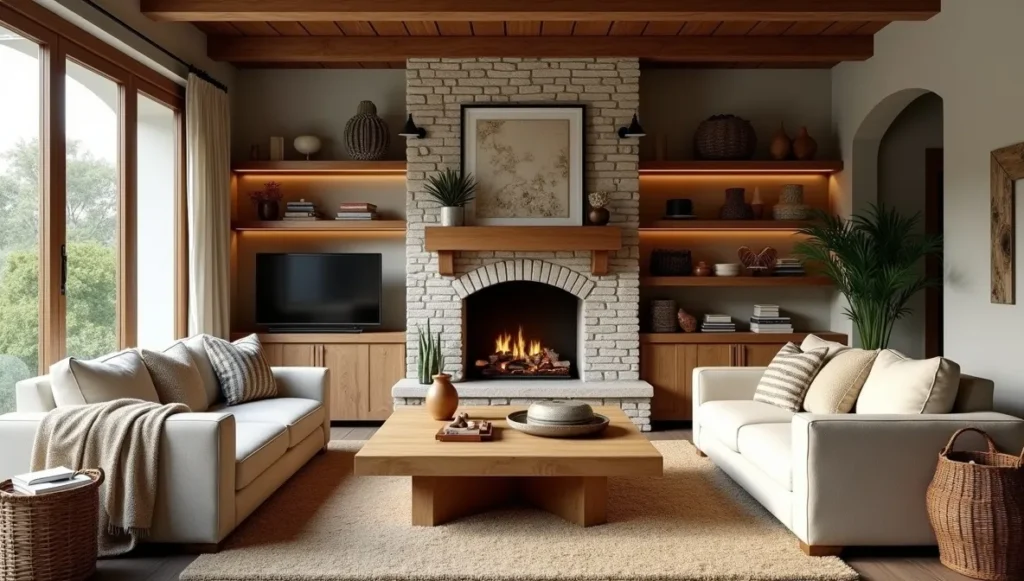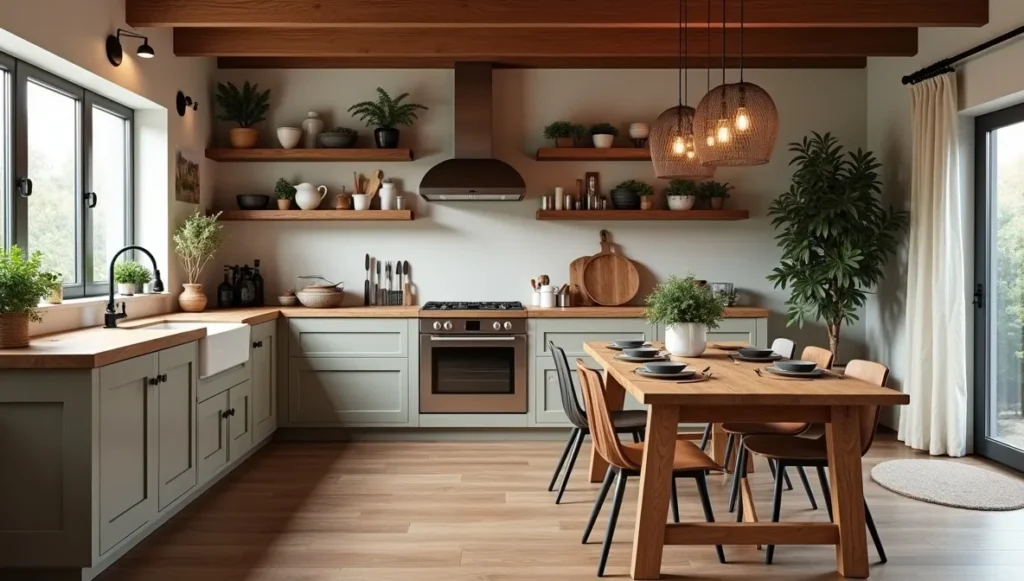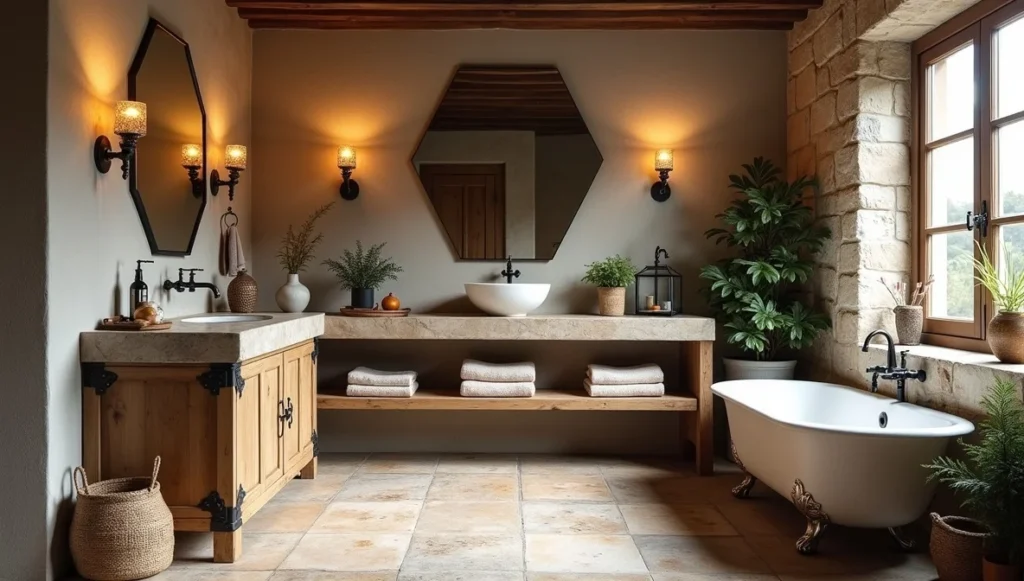Introduction
Rustic interior design brings a sense of warmth, comfort, and natural charm into a home. Characterized by earthy tones, raw materials, and vintage aesthetics, this style creates a cozy and inviting space that feels connected to nature. Whether you’re designing a countryside retreat or adding rustic elements to a modern home, this guide will help you master the rustic interior design aesthetic.
What is Rustic Interior Design?
Rustic interior design embraces a natural, organic, and aged look, often incorporating raw and distressed materials. Inspired by farmhouses, cabins, and traditional countryside homes, this style prioritizes simplicity and authenticity over perfection. Rustic decor includes wooden beams, exposed brick, reclaimed wood furniture, and warm color palettes, creating a homey, lived-in feel.
Key Characteristics of Rustic Interior Design
1. Natural Materials & Textures
Rustic homes emphasize natural elements such as wood, stone, metal, and linen. The use of reclaimed wood, stone fireplaces, and wrought-iron fixtures enhances the raw, organic appeal.
2. Warm & Earthy Color Palette
Rustic interiors often feature earthy hues like brown, beige, terracotta, deep green, and warm gray. These colors help create a cozy, grounded environment.
3. Handcrafted & Vintage Elements
A mix of antique furniture, handwoven textiles, and distressed wood gives rustic homes their unique character. Adding vintage decor items like old trunks, lanterns, and pottery can enhance the nostalgic charm.
4. Cozy & Functional Furniture
Rustic furniture is often sturdy, oversized, and comfortable. Large wooden dining tables, leather sofas, and plush armchairs create a welcoming and practical space.
5. Exposed Beams & Natural Light
High ceilings with exposed wooden beams and large windows that allow ample natural light are common in rustic interiors, creating an airy and open atmosphere.
6. Layered Textiles for Warmth
Rustic spaces incorporate soft, layered textiles such as wool throws, jute rugs, linen curtains, and plaid blankets, enhancing the warmth and coziness of the home.
How to Design Different Rooms in Rustic Style
Rustic Living Room

A rustic living room should feel warm and inviting. Use a wooden coffee table, stone or brick fireplace, and oversized seating with cozy cushions. Add vintage accents like wicker baskets, throw blankets, and distressed wood shelves.
Rustic Bedroom

A rustic bedroom should be a serene retreat with a wooden bed frame, neutral bedding, and antique bedside tables. Incorporate soft lighting with vintage sconces, pendant lights, or candle lanterns.
Rustic Kitchen & Dining
A rustic kitchen features open wooden shelves, butcher block countertops, farmhouse sinks, and wrought-iron lighting. The dining area can have a large wooden table with mix-and-match chairs, ceramic dinnerware, and a rustic chandelier.

Rustic Bathroom

Opt for a stone or wood vanity, clawfoot bathtub, and wrought-iron fixtures. Exposed pipes, distressed cabinets, and soft, earthy-toned towels add the perfect rustic touch.
Tips to Achieve the Perfect Rustic Look
- Incorporate reclaimed wood for furniture and decor.
- Use warm, earthy tones to create a cozy feel.
- Mix old and new—blend rustic elements with modern comfort.
- Add handcrafted pieces like woven baskets and ceramic pottery.
- Layer textures with soft fabrics, rugs, and blankets.
- Keep it simple—avoid clutter and embrace natural beauty.
Where to Buy Rustic Home Decor & Furniture?
You can find rustic furniture and decor at:
- Online retailers: Wayfair, Etsy, Pottery Barn, Anthropologie.
- Antique stores & flea markets for unique vintage pieces.
- DIY projects using reclaimed wood and handmade decor.
Frequently Asked Questions (FAQs)
1. What defines rustic interior design?
Rustic design is characterized by natural materials, earthy tones, distressed furniture, and vintage decor, creating a cozy and timeless aesthetic.
2. How do I make my home look rustic?
Use wooden textures, antique furniture, warm colors, and handcrafted decor to create a rustic ambiance.
3. What is the difference between rustic and farmhouse style?
Rustic design focuses on natural, rugged elements, while farmhouse style is more refined and blends rustic charm with modern touches.
4. What materials are used in rustic interiors?
Common materials include wood, stone, iron, linen, and wool, all of which emphasize warmth and authenticity.
5. Can rustic design be modern?
Yes! Modern rustic design blends minimalist elements with rustic materials, creating a stylish yet cozy home.
6. What are rustic colors?
Rustic interiors feature earthy hues like brown, beige, warm gray, deep red, and forest green.
7. Is rustic decor expensive?
Not necessarily! You can achieve a rustic look with budget-friendly DIY projects, thrifted finds, and simple natural elements.
8. Does rustic design work in small spaces?
Yes! Light wood, neutral tones, and multi-functional furniture can make a small space feel cozy yet spacious.
9. Can I mix rustic with other styles?
Absolutely! Rustic blends well with industrial, Scandinavian, bohemian, and modern styles.
10. How do I add a rustic touch without renovating?
Start with wooden decor, vintage accessories, cozy textiles, and warm lighting.
Conclusion
Rustic interior design is timeless, inviting, and full of character. Whether you want a full rustic transformation or just a touch of warmth, natural materials, earthy colors, and vintage elements can bring rustic charm into any home.
Are you ready to embrace rustic decor? Share your favorite rustic design ideas in the comments!
